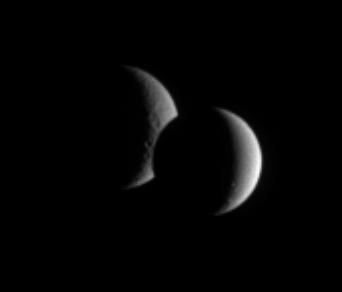Orbs Align

| PIA Number | PIA08183 |
|---|---|
| Language |
|
Dione and Rhea pair up for an occultation, or mutual event, as seen by Cassini. While the lit portion of each moon is but a crescent, the dark side of Dione has begun to take a bite out of its distant sibling moon.
Dione is 1,126 kilometers (700 miles) across and Rhea is 1,528 kilometers (949 miles) across.
The image was taken in visible light with the Cassini spacecraft narrow-angle camera on April 17, 2006 at a distance of approximately 3.4 million kilometers (2.1 million miles) from Dione and at a Sun-Dione-spacecraft, or phase, angle of 120 degrees. Resolution in the original image was 21 kilometers (12 miles) per pixel on Dione and 25 kilometers (16 miles) per pixel on Rhea. The image has been magnified by a factor of two and contrast-enhanced to aid visibility.
The Cassini-Huygens mission is a cooperative project of NASA, the European Space Agency and the Italian Space Agency. The Jet Propulsion Laboratory, a division of the California Institute of Technology in Pasadena, manages the mission for NASA's Science Mission Directorate, Washington, D.C. The Cassini orbiter and its two onboard cameras were designed, developed and assembled at JPL. The imaging operations center is based at the Space Science Institute in Boulder, Colo.
For more information about the Cassini-Huygens mission visit http://saturn.jpl.nasa.gov . The Cassini imaging team homepage is at http://ciclops.org .
Credit:NASA/JPL/Space Science Institute
